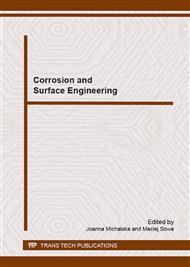p.439
p.443
p.447
p.451
p.455
p.459
p.463
p.467
p.471
Fretting – Corrosion of Co-Cr-Mo Alloy in Oral Cavity Environment
Abstract:
Fretting and fretting-corrosion processes in elements of kinematic pairs used for medical applications are observed in metallic orthopedic implants, dental prosthetics elements, and orthodontic appliances. In most cases, the degradation of biomaterials significantly limits their useful life and the comfort of patients. The products formed as a result of wear may lead to poisoning of the body and the occurrence of inflammatory states, which often results in the failure of medical therapy. Fretting-corrosion processes are being paid more and more attention, although there is not much data concerning the stomatognathic system. This article presents the results of fretting-corrosion studies of one of the most frequently used metallic biomaterials, CoCrMo cobalt alloy, in the presence of human saliva and its substitutes. The results of studies indicate that friction has a large influence on corrosion processes (fretting-corrosion). Artificial saliva compositions with favorable tribological and anti-corrosion properties were successfully developed and may find applications in the stomatognathic system, e.g. for the purpose of reducing the unfavorable effects of bruxism. Fretting-corrosion studies were performed using a self-designed original device. The obtained results of studies are of great significance in scientific and applicatory terms.
Info:
Periodical:
Pages:
455-458
Citation:
Online since:
January 2015
Authors:
Keywords:
Price:
Сopyright:
© 2015 Trans Tech Publications Ltd. All Rights Reserved
Share:
Citation:


